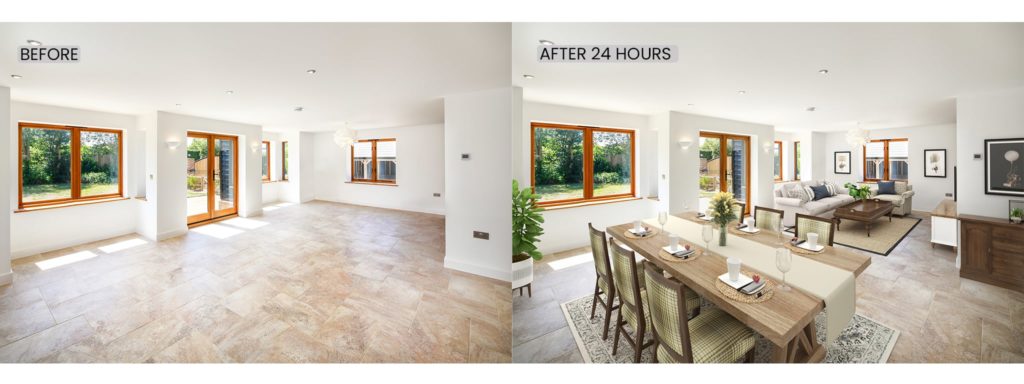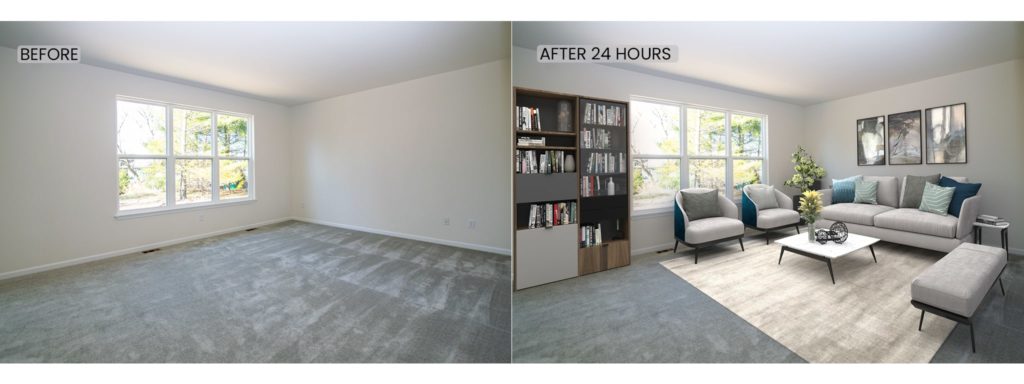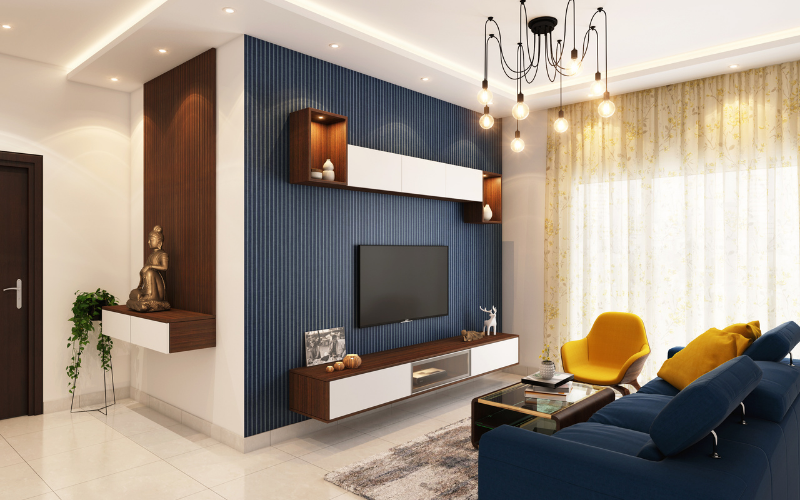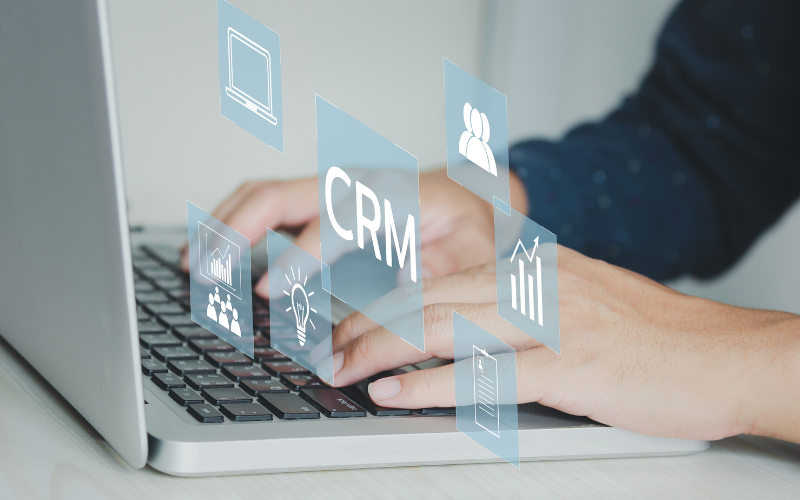With all of the advancements in technology and in the post-pandemic era, virtual reality, video tours, and virtual staging is becoming a must for every single realtor.
If the trend continues, many realtors will find virtual staging as a necessity rather than a “nice-to-have” feature.
Some real estate markets have a higher need for virtual staging than others. Markets where relocation clients are big business need to make virtual staging a key part of their listing marketing plan.
For example, a real estate market like Dallas, Texas should have listings with virtual staging. These markets have home buyers who are searching online for a home prior to moving down there.
In this guide, we’re covering everything a realtor needs to know about virtual staging. We’re covering:
- Is virtual staging is worth it?
- How to pay for virtual staging
- Your DIY options for virtual staging a home
- Virtual Staging Services
Let’s get started.
Is Virtual Staging Worth It?
In short, yes virtual staging is worth it. Virtual staging shares many of the same benefits as traditional staging and at a fraction of the cost. Often virtual staging is completed within 24 to 48 hours. Plus, there are a variety of styles to choose from and can even virtually stage a room differently to appeal to different markets.
With traditional staging, you have to pick one style and it’s not very easy to change the style.

Traditional staging costs a minimum of $2,000 to $5,000 depending on the market, number of rooms, and company you hire. It’s hard to make a profit on this cost unless you’re selling higher priced homes.
Regardless of whether you go the do it yourself virtual staging route or hire a service provider, virtual staging is by far more affordable than traditional staging.
Real estate agents asking this question are wondering one of two things (or maybe both)…
- Will virtual staging sell my listing faster and for a higher price?
- Is virtual staging expensive?
Let’s address both of these questions in a bit more detail.
How Effective Is Virtual Staging?
Since virtual staging is relatively new, there aren’t a ton of published studies that show the effectiveness of virtual staging. Instead, we’re applying the same logic and conclusions from traditional staging research.
According to research, staged homes sell 82 percent faster than a vacant home. It’s believed that a staged home allows buyers to envision themselves in a home and connect to it emotionally.
These are the same qualities that virtual staging can bring.
Many home buyers fail to see a home’s potential until it’s not appropriately staged. Since all home buyers start their search online, it’s important to have high-quality photos and virtually staged photos can go a long way in helping your listing.
So, yes, virtual staging is effective at selling your home faster and for more money. Virtual staging makes a difference when it comes to your listings.
Is Virtual Staging Expensive?
Costs to virtually stage a home can vary by solution and provider.
DIY virtual staging software can cost as low as $5 per month. If you get a listing every month and include 20 photos for every listing, then that boils down to about $0.25 per photo.
On the other end, virtual staging service providers can get expensive. Researching the different service providers is a must if you’re looking to control your costs and keep virtual staging affordable.
For example, some companies charge as much as $100 per image or as low as $19 per image. There is a wide range of service options so make sure to do your homework.
We’re sharing some options below, so keep reading this article.
How To Pay For Virtual Staging?
At the end of the day, every real estate agent’s goal is to sell the home for maximum value as quickly as possible while getting a good return on investment of their time and money.
Every real estate agent makes a living selling houses. Our profits and earnings can get eaten up if we spend too much marketing a home.
So, let’s talk about how to pay for virtual staging for every single listing. As a benchmark, the total costs of listing a home, including paying yourself, should cost around 25 to 30 percent of a home’s gross commission income after a broker’s split.
Here’s how that works…
You list and sell a home for $300,000 at three percent commission, giving you a gross commission income of $12,000. Your broker takes 20 percent, leaving you with $9,600 net profit.
Out of this amount, your total costs for working as a listing agent and marketing the home should be no more than $2,880, or roughly 30 percent. If you can drive this number down, the better.
With this information, we can set a marketing budget. First, let’s say your average time to sell a home is about 25 hours and the average real estate agent hourly wage is $45 per hour, or a total of $1,125.
This gives you $1,755 for marketing your listing. From this number, you can determine if you can afford virtual staging solutions.
In this case, it’s likely you have room in your budget to pay for virtual staging and still take home a good paycheck.
Match The Home’s Value To The Solution
As the value of a home goes down, you have less overall budget. The lower the home’s sale price, the less you can pay for virtual staging and other marketing efforts.
We looked at a $300,000 home but now imagine the home was only worth $150,000 with the exact same assumptions.
In this case, we would only have $315 for our listing marketing budget. At this point, you have a few options.
- Go the DIY virtual staging route
- Increase your commission split from 3% to 4%
- Or, create this as an add-on service for your sellers where you charge 3% plus the virtual staging fee
By understanding your numbers and working backwards, real estate agents can pick the solution that improves their service offering while allowing them to earn the most amount of money.
Best Virtual Staging Software & Services
Here we are listing various virtual staging software and service options. We’ve compiled a wide-array of providers to help you find a solution that matches your needs. The list, in no particular order, features DIY options, low-cost, or high-cost options.

Styldod
Best For: The real estate agent that is looking for affordable done-for-you virtual staging.
Styldod allows real estate agents to upload photos, select a design style, and then get their virtually staged photos within 24 to 48 hours.
Pricing varies between $16 and $19 per photo depending on how many photos you have virtually staged. If you get less than 8 photos, pricing is $19 per photo. For 8 or more virtually staged photos, the cost is $16 per photo.
Every real estate agent should be able to afford getting at least three to five photos virtually staged. This would cost approximately $60 to $100 more for your listing.
As of writing, Styldod is offering to do the first photo for free as a way to try out their service.
PhotoUp
Best For: Real estate agents looking for a done-for-you option with more customization and additional features, such as floor plans and simple photo editing.
PhotoUp can be a one stop shop for real estate agents to have their photos edited. In addition to creating virtually staged real estate photos, PhotoUp is able to edit your photos, create property websites, and create 2D or 3D floor plans.
Real estate agents are able to upload their photos, select the style, and customize their furniture options. Photos will be processed and completed within 24 to 48 hours.
Pricing is a little complicated. It’s based on a credit system. Each credit costs a different amount based on the subscription plan.
For example, a credit on their pay-as-you go option costs $1.50. A virtually staged photo from PhotoUp costs 25 credits, or $37.50 on their pay-as-you go plan for a single photo.
If you sign up for a regular subscription, you can reduce the cost.
They are more expensive than some of the options listed, however, PhotoUp does allow for greater customization of your photos. This may or may not be important to you.
roOomy
Best For: Real estate agents who are looking to virtually stage their 3D matterport tours and have a significant budget.
This virtual staging software is one the expensive side and likely worth it for agents focusing on the luxury market.
Most virtual staging companies only edit 2D photos. The roOomy software can add virtual staging to your virtual tours for $434.
For regular 2D staged photos, you can expect to pay between $49 and $89 depending on if the photo itself needs to be edited and cleaned.
At this price, you only want to go this route if you’re selling a home over $400,000. Anything less than that and you may have a difficult time getting your return on investment.
ApplyDesign
Best For: Real estate agents looking to stage a home that is occupied.
Let’s be real… sometimes clients don’t have the best decor or you have a client that is looking to sell a rental property. ApplyDesign is a great option for real estate agents that need to sell an occupied rental.
An agent can take pictures, ApplyDesign can declutter and remove items from the photos, and then virtually stage the photo.
ApplyDesing is fairly affordable. The cost of photos varies, but are as lows as $7 per photo if you buy their higher package option.
Like PhotoUp, ApplyDesign works on a credit basis. You buy credit and those credits are used to pay for the service.
It’s important to translate credits into dollars. Some companies chose this pricing model to cloak the cost of a photo and prevent real estate agents from price comparing.
It requires real estate agents to convert credits to dollars in order to compare different service options. Just be aware of this so you pick the option that is right for you.
Stucco
Best For: Agents looking for the most customization in their photos and pricing.
Stucco is a virtual staging software that has many of the features we’ve mentioned for the above companies.
The biggest advantage to Stucco is the ability to select a service option that matches exactly what you’re looking for. This way, you pay for what you need and don’t pay anything extra.
For example, just want the floor changed? You could pay $13.50 if you’re on the yearly real estate agent plan.
Depending on your photo editing and virtual staging needs, prices can quickly climb. It could be easy to spend $100+ on editing a single photo.
This virtual staging software is best for real estate agents selling $400,000+ homes or for real estate agents who need only minor changes to a photo.
BoxBrownie
Best For: Real estate agents looking to build a comprehensive listing profile.
BoxBrownie will help real estate agents with their virtual staging for $24 a photo. The company also helps with simple photo editing, item removal, floor plans, and day-to-dusk.
In addition, the company understands that your images can’t capture everything with a home. The perfect listing also includes a killer listing description. For that reason, BoxBrownie offers copywriting services.
They can help you write a listing description for Zillow, fill out a flier, or write content for a single property website. Copywriting starts at $28 for 150 words.
FAQs on Virtual Staging Software
What are the downsides of virtual staging?
There is additional time and costs associated with virtual staging. It’s cheaper than traditional staging, of course. If you plan to go the DIY route, there are some time costs and possible learning curves. Also, different services may not have the furniture or style you’re looking for. It’s not a perfect solution, but it is a better solution.
Is Virtual Staging Unethical?
Virtual staging is legal, however, there are some ethical concerns. Real estate agents worry about deceiving home buyers. We suggest making disclaimers and letting people know photos are virtual staged and edited. Especially if you plan to do item removals or renovations. Also, include the original photo in your listings and point out that the other photos are what the room could look like.
Other Benefits Of Virtual Staging
Security
When you have a vacant home that’s completely staged with expensive furniture, it can be an easy target for the burglars because it’s easy to steal from a place where no humans are present.
They are also known to look for vacant homes on real estate websites.

This compromises the security of your site and puts a lot of money at risk. You can avoid this by going for Virtual Staging because it doesn’t involve any physical goods and gives your buyers a better experience.
Target Specific Audiences
Virtual staging makes it easier for you to target multiple people with your design.
For example, if you are targeting the Millennials, you can adjust your home by adding features, colors, appliances, furniture, and design according to what’s trending among Millennials.
Same way, if you want to target an upscale audience, you can add luxury features and accessories to the same room and send them that plan. This isn’t possible when you decide to go for traditional staging methods.
Multiple Design Goods
When you go for traditional home staging, your choices become limited. Once you have bought the goods, there is no way you can make changes, and you are limited to targeting only a small group of buyers with that design.
However, virtual staging gives you the complete freedom to redesign your rooms as you want to.
You can play around with the room colors, modify a piece of furniture, make changes to the overall decoration, and the designer can do everything in a couple of hours. This gives you more freedom and allows you to experiment with your ideas.
Virtually Update The Home
One benefit to virtual staging is that you can take an old outdated home and update it by changing the color of the walls or flooring. This is a great way to help sell an outdated home that needs some love and repairs.
The only caveat is to make sure to include the original photo in its current condition so that you don’t deceive home buyers. Make sure home buyers are aware that the virtually staged photos are for illustrative purposes only.
But it’s a great way to help home buyers see the potential of a home.
Conclusion
Virtual Staging is a modern method that many real estate businesses use to stay ahead in this competitive market. It helps you to create a realistic version of your property and gives you the freedom to attract more buyers.
Therefore, it is recommended that you go with virtual staging when you want to save money and target a wider audience.
Disclaimer: this article was written in collaboration with Rahul from Styldod, a virtual staging real estate company.




